Getting Started
Biting into a succulent, perfectly ripe pear is one of the joys of autumn. You may be lucky enough to have a pear tree in your garden already, but if not, they’re easy to plant and you can even grow compact trees in containers.
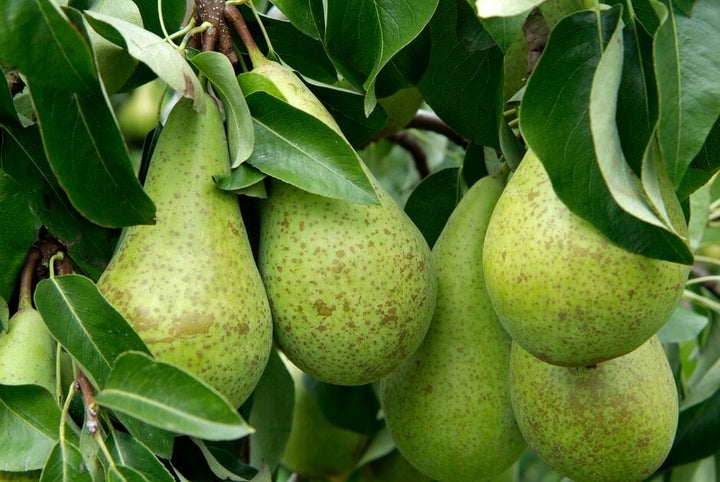
Pear trees announce the arrival of spring with a froth of joyful blossom, then the young fruits swell as the weather warms, to provide a plentiful harvest from late summer into autumn. Suitable for every size of garden, pears can be grown either as free-standing trees or trained against a wall to take up barely any ground space. Compact varieties and trees grafted on a dwarfing rootstock can even be grown in a large container.
There are many varieties of pear to choose from, producing fruit of different shapes, colours, flavours and textures. Pear trees need little maintenance once established, although it’s beneficial to prune them annually to keep them in good shape and fruiting well. The fruit should be harvested just before it’s ripe and brought indoors to complete the ripening process, which can take a month or more depending on the variety. This means you can enjoy your harvest gradually, savouring each sweet juicy fruit as it reaches perfection.
Jobs to do now
Plant new pear trees
Put supports in place
Prune newly-planted trees
Prune bush and standard trees
Month by Month
Plant
Harvest
Choosing What To Grow
There are lots of delicious varieties of pear (Pyruscommunis) to choose from, both for eating (dessert) and cooking (culinary). Take your pick from traditional favourites or more disease-resistant modern varieties. In colder regions, it’s best to choose one that ripens early, and for growing in containers, select a compact variety such as ‘Obelisk’. Varieties with an RHS Award of Garden Merit (AGM) performed well in our trials, so are reliable choices – see our list of AGM fruit and veg (135kB pdf) and our Recommended Varieties below. You'll also find pears growing in the orchards and fruit plots of the RHS gardens, so do visit to compare varieties and pick up growing tips.
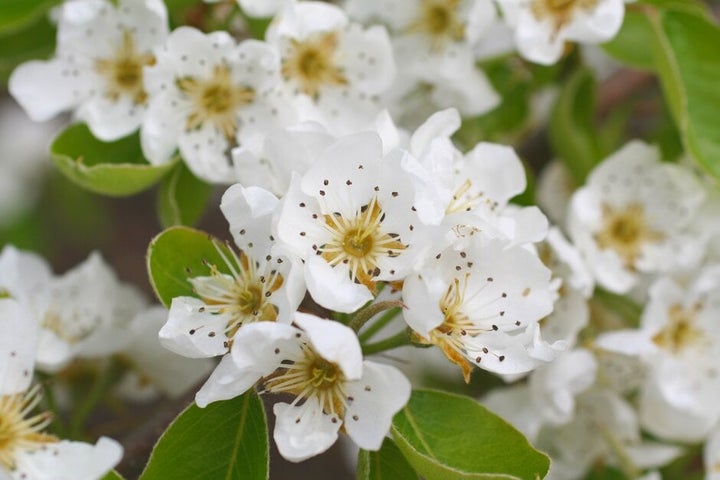
To get the best crop, most pear trees need their flowers to be pollinated by another pear variety flowering at the same time (a pollination partner), so check if there are pear trees growing in nearby gardens. If not, you’ll need to plant a second pear variety, making sure it will be a compatible pollinator. Alternatively, choose a variety that is self-fertile or partly self-fertile.
See our guides below for more advice:
Choosing pear rootstocks
As well as choosing the variety, you also need to choose the rootstock, which controls the ultimate size of the tree. Pear trees are not grown on their own roots, as they would get too large for most gardens, reaching 6m (20ft) or more. Instead, they are grafted onto quince rootstocks and the most widely available are:
- ‘Quince A’ – a semi-vigorous rootstock, producing a tree 3–4.5m (10–15ft) tall. It’s also suitable for espalier trees
- ‘Quince C’ and ‘Quince Eline’ – dwarfing rootstocks, producing trees 2.5–3m (8–10ft) tall, suitable for smaller gardens, for training as cordons and small espaliers, and for growing in containers. These trees are slightly quicker to produce fruit than those grafted onto ‘Quince A’
What and where to buy
A pear tree is a long-term investment, so always buy from a reputable specialist nursery or garden centre. Fruit or tree nurseries offer the widest choice of varieties. Pear trees are sold as young trees, ready for planting, in two forms:
- Bare-root trees – these are only available from late autumn to early spring, while dormant, for immediate planting, and are generally cheaper than trees in pots
- Container-grown trees – these are available all year round and can be planted at any time, but autumn to early spring is preferable
If you want to grow a trained pear tree, such as an espalier or fan, decide if you want to train it yourself from scratch starting with a one-year-old tree (maiden). If so, choose a tree with several well-placed shoots growing from the central stem. Alternatively, buy a partially-trained tree from a specialist nursery.
Recommended Varieties

'Beth' AGM
Early variety Small, sweet yellow/green fruits, ready to pick in early September. Compact tree.

'Beurré Hardy' AGM
Mid-season variety Good crops of high-quality, melting-texture, russet-brown fruits.

'Beurré Superfin' AGM
Late variety Excellent flavour but needs a warm, sheltered site to perform well.
Planting
The ideal position for a pear tree is somewhere sunny and sheltered – either an open site, such as in a lawn, or trained against a wall or fence. Avoid planting in a spot prone to late frosts, which can damage the flowers and reduce your crop. If you don’t have a suitable site to plant in the ground, a tree grafted on a dwarfing rootstock can be grown in a large pot.
The best time to plant a pear tree is while it’s dormant, from autumn to spring. Trees bought in containers can be planted at other times, but avoid planting in hot, dry weather or when the ground is frozen or waterlogged. Prepare your tree for planting by giving it a good watering if it’s in a container or by standing it in a bucket of water for half an hour if it’s a bare-root tree.
No soil preparation is generally needed before planting. However, if your soil is poor, dig a bucketful of organic matter, such as garden compost or well-rotted manure, into the soil you remove from the planting hole and use this to backfill after planting. This minimises soil disturbance and helps your tree get off to a strong start.
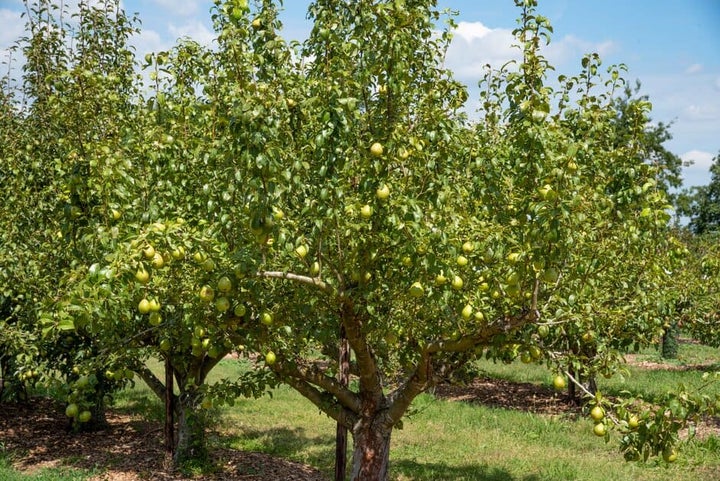
If planting in a lawn, remove a circle of grass at least 1m (3¼ft) in diameter, so the tree’s roots don’t have to compete for water and nutrients while they get established. If planting more than one, space trees 3.5–5.5m (11–18ft) apart if grafted on ‘Quince A’rootstock and 2.5–3.5m (8–11ft) on ‘Quince C’or‘Quince Eline’.Support free-standing trees with tree stakes, putting them in place at planting time.
If planting a trained form (such as a cordon, espalier or fan) against a wall or fence, attach horizontal wires before planting and plant the tree about 30cm (1ft) from the base. If planting more than one, space them at least 3.6m (12ft) apart for espaliers and fans, and around 75cm (30in) apart for cordons.
For more advice on planting your pear tree, see our guides below:
Planting in a container
For growing in a container, choose a tree on a dwarfing ‘Quince C’ or ‘Quince Eline’ rootstock, which will keep it compact. The container should be 45–50cm (18–20in) wide and deep, and heavy and stable enough not to blow over in windy weather. Fill with a good-quality, loam-based compost, such as peat-free John Innes No.3, and position in a warm, sunny, sheltered spot, such as on a south or west-facing patio.
Plant Care
Newly planted pear trees and those growing in containers need some regular attention to ensure they establish well and produce a good crop. Once established, trees growing in the ground need very little ongoing maintenance.
Watering
- Newly planted pear trees should be watered regularly during dry spells for the first couple of years after planting
- Trees in containers need a steady supply of moisture throughout the growing season, so water regularly in dry spells, aiming to keep the compost evenly moist
- Established treesin the ground shouldn't need watering, except during very dry spells when the fruit is starting to swell
Try to water early in the morning or late in the evening to minimise water loss from the soil, ideally using stored rainwater.
Mulching
Mulch pear trees growing in the ground each spring, spreading a thick layer of organic matter, such as garden compost or well-rotted manure, on the soil around the base of the trees. This helps improve soil fertility, reduce moisture loss and suppress weeds. Just make sure to leave a small mulch-free circle immediately around the base of the trunk to prevent rotting.
Feeding
Pear trees growing in regularly mulched soil shouldn't need any additional feeding. However if harvests are particularly poor, or your tree is showing signs of nutrient deficiency, apply a granular fertiliser to the soil in early spring. Use our page on nutrient deficiencies to work out what is lacking and apply the recommended feed, following instructions on the packet.
Pears growing in containers benefit from regular feeding. Either apply an organic, high potassium liquid fertiliser every fortnight through the growing season, or sprinkle a handful of a granular, general-purpose fertiliser onto the compost each spring.
Repotting
Container-grown trees need repotting every few years into a larger container of peat-free compost; this is best done in spring. Once it becomes impractical to move the tree to a larger pot, repot into the same one, removing and replacing any loose compost and lightly trimming the roots.
In the years between repotting, topdress by removing the top layer of compost and replacing with fresh.
Fruit thinning
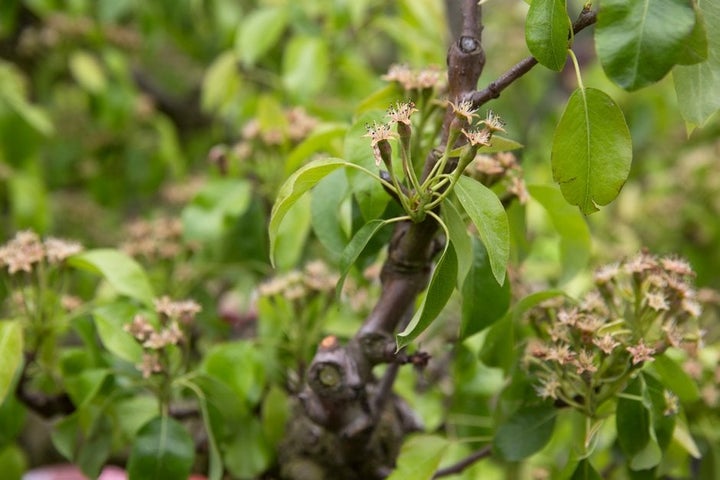
Pear trees naturally shed excess young fruits in early summer, known as the June drop. However, if your tree is still carrying a heavy crop by mid-summer, it can be beneficial to remove some of the overcrowded fruits. This may seem like a shame, but it helps to ensure the remaining fruit develop and ripen well and limits stress on the tree, reducing the likelihood of biennial bearing.
It is easiest to thin out fruits on trained pear trees – with these, reduce the crop to one fruit per cluster, 10–15cm (4–6in) apart. On free-standing pear trees, if you can reach the fruits, thin them to two fruits per cluster, 10–15cm (4–6in) apart.
Pruning And Training
Pear trees should be pruned every year to ensure you get the best crop. Start pruning newly planted trees straight away. When and how to prune established pears depends on the type of tree:
- Free-standing pear trees should be pruned in winter, to keep them healthy, in good shape and to promote fruiting
- Trained pear trees should be pruned in late summer, to restrict their growth and improve fruiting
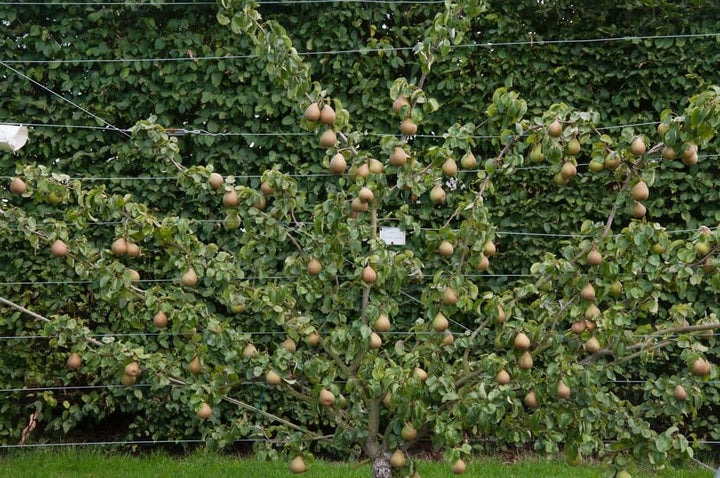
Pear trees can be trained into various shapes to limit their size and the amount of space they take up, and to create an attractive feature. Trained trees are ideal for small plots and make harvesting the fruit easy. Pear trees are often pruned into the following shapes:
- Cordon – a single stem, usually at a 45 degree angle, with very short side branches that carry the fruit
- Fan – a short trunk with a fan of branches radiating out at the top
- Espalier – a central trunk with several tiers of horizontal branches on each side
- Stepover – a very short trunk with a low pair of horizontal branches on each side, to form a T-shape
If you have an old, overgrown pear tree, you can get it back into shape and improve fruiting by renovation pruning.
Harvesting
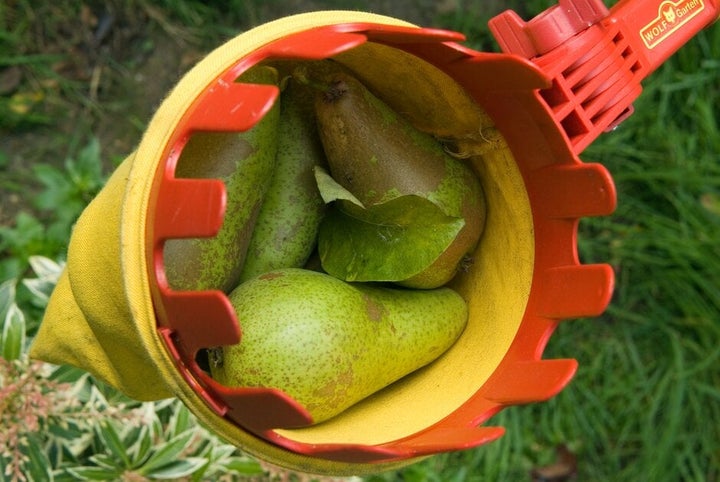
Pears should be picked just before they’re fully ripe, when they are firm and swollen, with a subtle colour change to their skin. Test early varieties by tasting one of the fruits for sweetness. Later varieties should come away from the tree easily when lifted and gently twisted. Harvesting fruit from a tall tree can be tricky – the safest option is to use a long-handled or telescopic fruit picker. Take care if harvesting by hand up a stepladder.
Pears benefit from a period of ripening in storage before you eat them – early varieties usually need a week or so until they become softer, while later ones can take months. Press gently, looking for a slight softness, especially around the stalk. Unripe pears should be stored in a cool, dark place, such as a garage, on slatted trays or crates with good air circulation. Make sure the fruits don't touch in storage. Check them regularly for ripeness, so you can enjoy them at their best.
Problem Solving
Pear trees are generally robust, hardy and easy to grow, reliably producing a good crop. However, adverse weather conditions can affect cropping:
- Late frosts and spring storms – can damage blossom and deter pollinators, leading to fewer fruits. As pears flower significantly earlier than apples, they are at a greater risk. If a late frost is forecast when in blossom, cover smaller trained trees with biodegradable fleece or hessian, or bring container-grown plants indoors. Avoid planting trees in sites prone to late frosts. See our guide to protecting fruit from frost
- Lack of water – can cause too many young fruitlets to drop in summer, so water in prolonged dry spells while the fruits are forming. This is especially important for trained trees on dwarfing rootstocks, where a large crop is produced by a small tree
Pears can also be affected by various diseases and insects – see Common problems below.
Common Problems

Apple canker
Apple canker is a fungal disease causing disfiguring and sunken patches of dead bark on the branches of apple and some other trees. Infections often b...

Apple scab and pear scab
Apple scab and pear scab are two fungal diseases that cause dark, scabby marks on the fruit and leaves of apples, pears and some other ornamental frui...

Fruit: biennial bearing
Biennial bearing is a problem in some fruit trees, particularly apples and pears, where they crop heavily in one year and then produce little or nothi...













